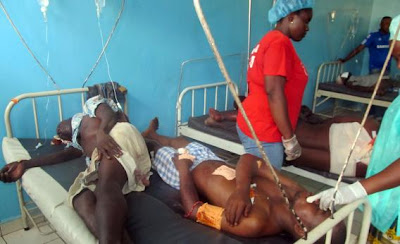Primum non nocere – first, do no harm – seems a reasonable
thing to ask. But has the western approach to aiding developing
countries, and particularly in sub-Saharan Africa, done inadvertent
harm? I would argue yes, and also that there is a deep reluctance among
well-meaning people, institutions and billionaires to reconsider the
paternalistic approach.
Meanwhile, the continued relative importance of foreign donors – whether public or private – has emerged as a risk in itself to the goal of building a sustainable health care infrastructure in sub-Saharan African nations. To say the least, these are no boom times for non-profits, and the political climate in Washington has rarely been less generous.
In the autumn of 2011, Laurie Garrett, a former colleague of mine at the Council on Foreign Relation whose work is funded in part by the Bill and Melinda Gates Foundation, spent an afternoon in the University Teaching Hospital in Lusaka, the Zambian capital. Garrett, who wrote about this last year in Foreign Affairs, had spent the past decades wrestling with the long-term consequences of sub-standard health care systems in sub-Saharan Africa, beginning in the mid-1990s, when she won a Pulitzer Prize for her reporting on the Ebola outbreak of the mid-1990s in what was then Zaire.
After years of cheering the emergence of huge new international organizations devoted to African medical issues – including the Gates Foundation itself – she grew concerned about the growing dependency of Africa’s still creaky national health systems on “fickle” foreign donors, and particular on the negative implications of groups that poured billions into the continent to fights specific diseases rather than building local medical capacity. But even Garrett was unprepared for what she encountered in Lusaka.
“Here it was, in all its absurdity,” she tells me. “I discovered an entire cancer ward staffed by three nurses, no physicians, with more than 100 patients dying on morphine drips in 100 degree temperatures as thieves wandered through stealing their belongings. Meanwhile, down the hall was an air conditioned, gleaming high-security ward for HIV/AIDs sufferers paying higher wages and, thus, overflowing with doctors.”
Only now, she says, as the true depth of the 2008 global financial downturn sinks in, have the dangers of such “siloed” international aid programs become clear. EU aid, once vying to outdo aid from Washington, is dwindling at an alarming rate, primarily as result of the eurozone’s sovereign debt crisis. For instance, Italy, which donated nearly $1 billion annually from 2001 to 2008, gave nothing in 2009 and has given almost nothing since, according to a report by the Brookings Institution.
Not surprisingly, Greece, which provided more than $50 million in global health assistance in 2007, now gives nothing. Iceland stopped making commitments and contributions in 2008, Portugal in 2009, and Spain in 2010. Garrett notes that “In 2009, 94 percent of all global health promises made by the European Union and its member countries were actually disbursed, but by the end of 2010 only 78 percent were, and the gap appears to have widened further in 2011.”
While US contributions – public and private – continue to flow into a panoply of programs, this spigot, too, may soon begin to close. A new proposal by the Obama administration, the US Global Health Initiative, addresses the silo issue in its emphasis on funding local health infrastructure, but in the current American political environment may fail to get through Congress.
Official US health care aid to sub-Saharan Africa – some $6.2 billion or 52 percent of all government aid to the region in 2011 – is under attack for lack of what Ilena Ros-Lehtinen, the Republican chairwoman of the House Committee on Foreign Affairs, deems a poor “return on investment.
The vulnerability is recognized in Africa, too.
Dambisa Moyo, a Zambian-born economist and author of the controversial book, “Dead Aid: Why Aid is Not Working and How There is a Better Way for Africa,” argues that aid should be building Africa’s ability to handle its own problems, not merely providing “band aids” for one crisis after another, like the huge PEPFAR HIV/AIDS program run by the U.S. government.
“Health care, education, infrastructure and even security are public goods,” she argues. “They are goods that the governments of Africa are supposed to supply for their people … “The fact is, the PEPFAR programs are unsustainable, the United States has a 10 percent unemployment rate and we’re in the middle of a credit crisis,” she told an interviewer last year. “Are we creating an environment in Africa that in 10 years, 20 years, 30 years, African governments are going to take responsibility for that? “


No comments:
Post a Comment